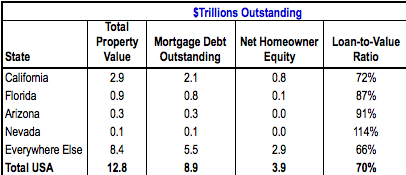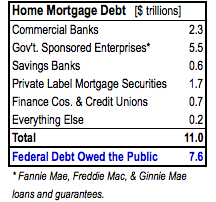
For OpEdNews: David Fiderer - Writer
Beware of national averages like“One in Four Borrowers Is Underwater.”The problem is heavily concentrated in places like Phoenix, where 54% of homeowners with mortgages have negative equity. That's about half a million underwater mortgages, more than the combined totals in Texas and New York state, where 10 times as many people live.
University of Arizona law professor Brent T. Whitesays anyone with negative home equity should simply walk away. Arizona, like California, is a non-recourse state, where a home lender cannot legally pursue repayment beyond the value of the underlying collateral.
The situation looks much worse in America's Dubai, Las Vegas. Almost three-quarters Las Vegas homeowners with mortgages have negative equity or near negative equity. A lot of them arereallyunderwater. Almost half of Nevada homeowners with mortgages have negative equity in excess of 25%. The total residential mortgage debt in Nevada is 1.14 times the value of the underlying real estate.
The majority of America's underwater mortgages, about 5.5 million, are located in the four sand states: California, Florida, Arizona and Nevada, according to a new study by First American CoreLogic. That's where homeowners face each month with a renewed sense of anxiety.Many wonder if the next mortgage payment means throwing away good money after bad. And almost all wonder how the next foreclosure will affect neighborhood property values, and the fabric of their community.
Don't feel smug if you live elsewhere, say Deutsche Bank analystsKaren Weaver and Ying Shen. By 2011, they predict,one halfof all American homeowners will have negative equity, plus another 20% who will have borderline negative equity. They expect the New York market, which so far has held up fairly well, to collapse. By 2011, they estimate, three-quarters of homeowners in the New York-White Plains-Wayne, NY-NJ market will be underwater.
Whichever numbers you accept, it's clear that the size of this mortgage crisis dwarfs everything else, including healthcare reform, the war in Iraq and social security. America's $11 trillion in home mortgage debtis 45% larger than public debt owed by the federal government. And half of that $11 trillion was lent or guaranteed by Government Sponsored Enterprises like Fannie Mae or Freddie Mac. It's not just the solvency of the GSEs that's at stake; it's the health of the overall economy. Federal revenues were down by$400 billionthis year because people have less taxable income.
President Obamawill issue admonishments to the banks.Robert Reichsays we should change the bankruptcy laws to allow for cramdowns. All well and good, but it's unrealistic to hope that banks will fill the vacuum of leadership at the top. We're talking about sorting out the problems of 10 to 15 million individual mortgage loans. The financial incentives are too fragmented and too misaligned and too nontransparent for any private party to sort out the mess. Given the numbers involved, these mortgage problems are too big, and too interconnected, to be resolved on a scattershot basis in a dysfunctional marketplace.
If the government wants the job done right, it must do the heavy lifting itself. Here are the three proposals to untangle the mortgage mess:
1.Perform due diligence on all borrowers at risk.
Step one is to find out what's going on with each distressed borrower. It's a very time consuming and labor intensive job, which is why no one wants to do it. It requires a face-to-face meeting with the borrower, plus independent verification of a borrower's employment and income, his financial assets and obligations. It requires figuring out if the borrower would be motivated to continue servicing the loan if it were reduced to an amount below the property's current market value.
Each delinquent mortgage loan is a multi-layered story. Some borrowers took out mortgages as part of a flipping scheme. Some, who took out loan they could not afford, were deceived by dishonest mortgage brokers. Others took out a fully-documented 80% loan on a house that lost 50% in market value. All the evidence shows that mortgage fraud went viral during the real estate boom.
The root cause of the mortgage meltdown, and most other financial scandals, was that everyone piggybacked off of somebody else's due diligence, which was never performed properly in the first place. As a substitute, investors relied on credit ratings and financial models that were fatally flawed. Now that millions of borrowers are in trouble, everyone acts as if the situation can sort itself out on its own. If we really want to take charge of the problem, the federal government should temporarily hire 50,000 people to perform actual due diligence on these borrowers and loans. The private parties who contributed to the situation don't have the same incentive to do things right. They're conflicted.
2. Nationalize loan servicing for private label mortgage securitizations.
When mortgage loans are sold to securitizations, the loan servicing process is outsourced to a company that has no financial stake in the loans and has all sorts of incentives to play all sorts of tricks on the borrowers. The loan servicer is ostensibly acting on behalf of the security holders, who, because if different levels of subordination, have varied and conflicting claims. The problem is compounded by the fact that none of the private label mortgage securities have standardized loan documentation or workout policies. The incentives are very different when a bank keeps a loan on its own books, or when Fannie Mae guarantees mortgage-backed securities. In those instances, one creditor has a singular financial interest in working out the best possible solution for a problem loan.
By nationalizing this function, the federal government would be able to assure that the workout function would be done with honesty and integrity.
3.Create a transparent national registry for every ownership claim, including every derivative claim, on a mortgage securitization.
Here's a very common scenario in loan workout negotiations. Several creditors agree to some kind of temporary forbearance to keep the borrower out of bankruptcy. But one holdout creditor shows no flexibility. He prefers to push the borrower into bankruptcy, even if it means that the eventual recovery will be far less. The holdout owns a credit default swap, kept secret from everyone else, that will reimburse him immediately. With complex securitizations and credit default swaps, the opportunities for bad faith dealings in debt restructuring grow exponentially.
The only way to achieve an orderly and fair workout process is to clarify who comes to the table with clean hands.
Once the government assembles the data of what's actually happening, it can assert pressure to enforce an orderly and reasonable restructuring of America's financial albatross.
Of course, this approach holds political peril. It's easier to harangue against the banks than it is to take responsibility for the mess created by someone else. Any kind of government intervention is red meat for the tea bagging crowd. Remember how it all started in February 2009?
Do we really want to subsidize the losers' mortgages? This is America! How many of you people want to pay for your neighbor's mortgage? President Obama, are you listening?" We're thinking of having a Chicago Tea Party in July. All you capitalists that want to show up to Lake Michigan, I'm gonna start organizing.
CNBC's Rick Santelli, who disclaimed any political affiliation after his famous rant, provided inspiration forLarry Kudlowand countless others. You would think that people would have wised up by now. But consider this, the sand states' economies are all blighted by record multi-year droughts. Yet large blocks of voters are still brainwashed by a cable network that says global warming is not real.
Finally, here are the numbers, simplified:


Source:First American CoreLogic

Sources:Federal Reserve,Congressional Budget Office
For over 20 years, David has been a banker covering the energy industry for several global banks in New York. Currently, he is working on several journalism projects dealing with corporate and political corruption that, so far, have escaped serious (
more...)
The views expressed in this article are the sole responsibility of the author
and do not necessarily reflect those of this website or its editors.





No comments:
Post a Comment